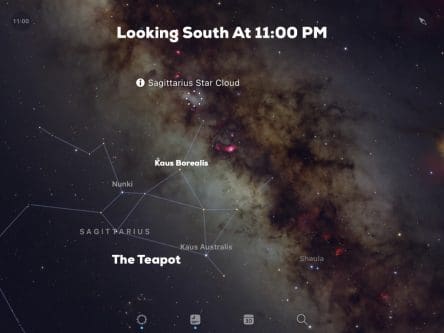July 2021 Feature – Cloudy With a Chance of Stars

As we enter into our second summer of the pandemic, there has been an interesting side effect to have emerged from all the misery it has brought: people have been inspired to turn to the night sky in order to find comfort, meaning, and for exploration. As more and more people have entered into the hobby of amateur astronomy, worldwide sales of binoculars and telescopes have surged to unheard-of levels. Back in November of 2020, I placed an order for an entry level telescope as a Christmas gift for a special someone. It had been sold out for over two months and the manufacturer had no clear idea as to when the order could be filled. It finally arrived in March of this year. And it wasn’t just this single telescope vendor, everywhere I searched the story was the same, telescopes were flying off the shelves and manufacturers simply could not keep up with demands.

In an article from October 16, 2020, at the Sky and Telescope Magazine website, Jeff Simon, director of Sky Watcher North America stated, “I’ve never seen this kind of growth in the industry. We often see a bump in interest around a big event such as a total solar eclipse or a bright comet, but this has been unprecedented.” For some companies, sales had jumped as much as 60% to 400%. Faced with isolation and social distancing, unable to gather with those we love or to even travel to vacation destinations, we all have had at least one thing to connect us on a truly universal scale: the stars above. We really are all one people, living together under one sky and the shared experience of looking up in wonderment into the starry heavens is one that binds us like no other. Armed with just a simple pair of binoculars, and from the safety of our own backyards, we can get outside and explore the very universe itself, where the only fear of contagion is that of being overtaken by the astronomy bug.
It is my hope that, as we look towards a recovery from this pandemic, that people will stick with their newfound hobby in order to discover the many wonders overhead and summer is a perfect opportunity to spend more time outside at night doing so. So, slather on your bug spray, grab your binoculars or telescope, and let’s get outside to track down two particular celestial treats.
WHAT ARE WE LOOKING FOR?

The summer night sky is an embarrassment of riches. As an example, July to October is a great time to observe the summer Milky Way. Our Sun is just one of billions of other stars embedded inside the disc of our Galaxy, which we see as a band of ghostly light all this month at around midnight, rising up from the south, arching high overhead through the constellation of Cygnus and disappearing towards the northeast. It is a glorious sight from a dark sky location and one you will not soon forget. Our galaxy is shaped somewhat like a pancake and the Sun and Earth are stuck inside its disc, 28,000 light years from the center. During the winter, our view of the Milky Way faces outwards from the center but, in summer, we are staring right towards the crowded heart of galactic central. All along that band of milky white is a veritable treasure trove of deep sky objects, many of which are accessible with binoculars.
The light that you see making up the Milky Way’s glow is the combined light of countless millions of stars spread out all along the thickness of the galactic disc and blending together to form the shimmering band we see stretching across our summer sky. Gazing towards the asterism known as “The Teapot”, an easily recognizable pattern of stars in the constellation of Sagittarius, there lies a particularly dense gathering of stars known as the Small Sagittarius Star Cloud (or, Messier 24). Just below it, and a little to the right, is a stellar nursery, a place where stars are actually being born, known as the Lagoon Nebula (or, Messier 8).
MESSIER WHAT?

Charles Messier (pronounced, “mezz-ee-ay”) was an 18th century comet hunter who kept getting distracted by comet impostor objects. He was always stumbling across these faint and fuzzy objects that resembled comets in appearance but, after devoting precious time in observing them, turned out not to be the icy snowballs he so devoutly wanted to find. So, he began to catalog them in order to keep him and his comet hunting bros from bothering with them. No one knew what they were other than that they were “nuisance objects”. Turns out that the 110 objects he and others cataloged are some of the best deep sky objects to view in binoculars or telescopes: nebulae, star clusters, and galaxies. You can learn more about Messier in a previous episode I did for The Night Sky called, “Hooray For Mr. Messier”.
SMALL SAGITTARIUS STAR CLOUD, MESSIER 24

M24 is an oddity within the Messier Catalog. Whereas the vast majority of the 110 entries represent individual objects (i.e. a galaxy, nebula, or star cluster), M24 is really just a line of sight effect created by a particularly dense region of unrelated stars within the Milky Way. All of these stars reside within the Sagittarius Arm of the Galaxy and it is the densest concentration of stars that you can see through a pair of binoculars. And I do recommend that you observe M24 with just binoculars. While all the stars you see in M24 are within 10,000 to 16,000 light years away, this region of stellar density is only about 600 light years wide. This translates into an area upon the sky of about 4 degrees, or about 8 full moons. In a pair of binoculars, you will see approximately 1,000 individual stars within a single field of view. A telescopic view is just going to have too narrow a FOV and you will not be able to fully appreciate the grandeur afforded by the more generous FOV of binoculars.
FINDING M24 AND WHAT YOU ARE SEEING

Provided your sky is dark enough, you should be able to see M24 with just your unaided eye as a large, fuzzy patch of light upon the sky. To locate it, find the asterism known as “The Teapot”, a pattern of stars in the constellation of Sagittarius that really does look like what it’s named after. Find the star Kaus Borealis, a star making up the tip top of the pot’s lid. Look about 7 degrees above Kaus Borealis and a little to the west to find the cloud. The distance across your fist held at arm’s length is 10 degrees.
As I intimated earlier, M24 is not a single object in the traditional sense when talking about most other Messier Catalog entries. As we look off in this direction of the sky, we are looking towards the center of our galaxy but more often than not, our line of sight is blocked by vast clouds of intervening gas and dust. M24 is actually an open window of sorts towards the center of the Galaxy that is relatively free of this gas and dust. But it’s not entirely free, there are a few dense clumpings of gas and dust that are impenetrable to visible light, and we call these dark clouds, “dark nebulae”. These dark nebulae are cold and dense, just the place where, one day, new stars will be born. In fact, located within the brightest region of the cloud is a small, dim open cluster of 30 relatively young stars that were all born together and at roughly the same time, NGC 6603.
DIVING INTO THE LAGOON NEBULA, MESSIER 8

Stars are hatched inside nurseries of dense, cold clouds of molecular hydrogen. As the stars emerge from out of their cocoons of gas and dust, the high energy UV photons they emit excite the atoms of the surrounding gas, making the clouds glow. It’s something that astronomers call an “emission nebula” and Messier 8, otherwise known as the “Lagoon Nebula” is an example of one. Whether you are using binoculars or a small telescope, M8 is a gorgeous sight.
HOW TO FIND M8

Go back to the Teapot. Locate the star Nunki in the Teapot’s handle and the star Kaus Borealis that forms the very top of the pot’s lid. Draw an imaginary line in between these two stars, now extend that line for the same distance in a westerly direction. At the end of the line, you will be right around the general area of M8. If your skies are suitably dark, M8 will show up as a softly glowing fuzz patch of light.
OBSERVING M8

In binoculars, you will definitely see M8 as a glowing cloud with several stars placed around it. In a telescope (even small ones) you can see much more detail in the nebula. Most notably, a dark dust lane cutting down the middle of the nebula, forming the lagoon of its namesake. Larger aperture scopes will reveal even more details in the nebula. M8 spans the width of 3 full moons, so be prepared to use an eyepiece with as generous a FOV as possible in order to appreciate the nebula in all its glory. Try using a nebula filter to help bring out more contrast. And, I shouldn’t have to say it, but find as dark a sky location as possible when you observe it for best results.
Want to see even more detail in M8? Take a look at this stunning image from the Hubble Space Telescope, taken in 2018 in order to celebrate Hubble’s 28th year of operation. Not only do the hot, young stars emit ionizing radiation, making the nebula glow, that radiation, and the fierce stellar winds that the stars emit, are also carving up the nebula into an intricate and wildly beautiful fantasy landscape.
Remember what you are looking at here with M8. It’s a stellar nursery, a place where stars are actively being born. We don’t know exactly how much gas and dust make it up, but conservative estimates say that there is at least enough to make some 1,000 suns. The two most conspicuous stars that you see inside it while observing it are only a couple of million years old, quite young on cosmic time scales. What’s more, it’s these very stars whose radiation is making M8 glow.

Our summer night sky has a lot to offer for both binoculars and small telescopes and there are plenty of wonderful field guides on the market but for the beginner, I might recommend any of author John Read’s “50 Things to See…” series of books. Online, I highly recommend that you head over to David Fuller’s Eyes on the Sky website and check out his observing tutorial section where he curates a list of the best objects to see in telescopes and binoculars, many of which can be found in our summer sky. Don’t let the fear of the pandemic isolate you entirely, the sky above is full of awe and wonder and I encourage you to get outside and explore it.
